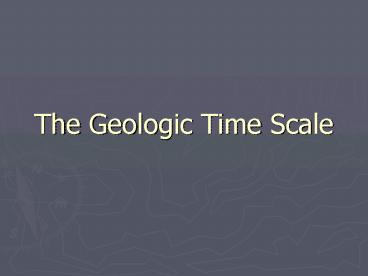The Geologic Time Scale PowerPoint PPT Presentation
1 / 14
Title: The Geologic Time Scale
1
The Geologic Time Scale
2
Age of the Earth
- According to radioactive dating, the earth is
estimated to be 4.6 billion years old. - The Geologic Time Scale is a record of the life
forms and geologic events in Earths history. - Simple single celled life is estimated to have
formed 3.5 billion years ago. - Animals appeared 600 million years ago.
3
Geologic Time Divisions
- The Geologic Timeline begins with Precambrian
time. - Precambrian time takes up 88 of Earths history.
- The 2 other basic units of geologic time are eras
and periods. - There are 3 eras, and the periods are smaller
divisions within the eras.
4
Paleozoic Era
- Many life forms began to evolve during the
Cambrian Explosion. - Life went from simple invertebrates in the
oceans, to more complex and diverse life forms on
land. - The first plants, fish, amphibians, and reptiles
evolved in the paleozoic era.
5
(No Transcript)
6
Mass Extinction
- At the end of the Paleozoic era, a mass
extinction occurred that killed off almost 90 of
marine species. - Scientists do not know what caused the
extinction, but it could have been caused by
climate change resulting from continental drift.
7
The Mesozoic Era
- Some plants and animals did survive the Permian
extinction, including fish, reptiles, insects and
conifers. - The Mesozoic Era is known as the Age of Reptiles.
- The first dinosaur appeared about 225 million
years ago.
8
Mesozoic Era
- Mammals first evolved during the Triassic period.
- During the Jurassic period dinosaurs ruled the
Earth for about 150 million years. - Scientists have identified several hundred types
of dinosaurs. - First birds also evolved during the Jurassic
period. - Scientists believe that birds evolved from
dinosaurs.
9
Mass Extinction Again!
- At the end of the Cretaceous period, about 65
million years ago, a mass extinction occurred. - Scientists hypothesize that this was caused by a
massive object from space hitting Earth.
10
The Cenozoic Era
- Called the Age of Mammals.
- They were no longer competing with large reptiles
for food, space and survival. - The extinction of dinosaurs created an
opportunity for mammals.
11
(No Transcript)
12
The Cenozoic Climate
- During the tertiary period, the Earth was
generally warm, and on land flowering plants,
insects, and mammals flourished. Many mammals
became large. In the oceans whales evolved.
13
The Ice Ages
- During the Quaternary period, the Earths climate
cooled, and species had to evolve to deal with
several ice ages. - In the ocean, algae, coral, fish, and mammals
thrived. - On land, flowering plants and mammals such as
cats, dogs, cattle, and humans became common.
14
Early Humans
- The fossil record shows that modern humans may
have evolved 100,000 years ago. - By about 12 15,000 years ago, humans had
reached every continent.

